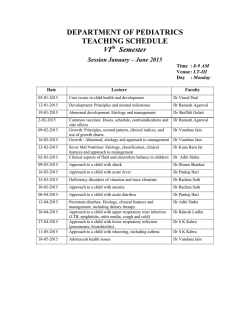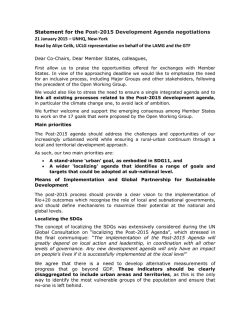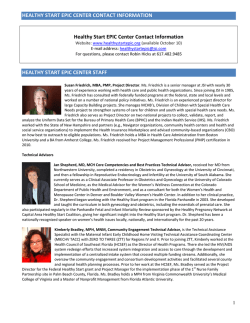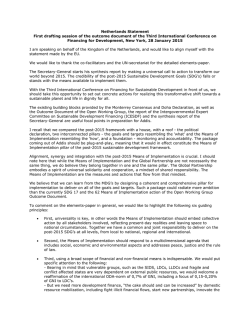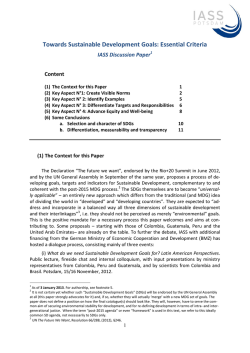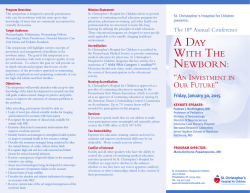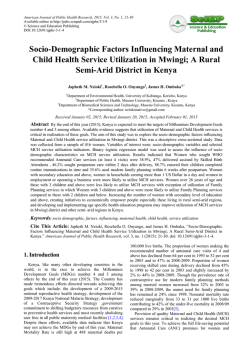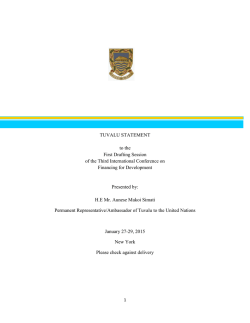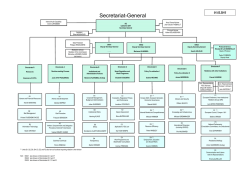
Download Resource - Healthy Newborn Network
World Report PMNCH gains traction and a new leader The new head of the Partnership for Maternal, Newborn & Child Health faces a challenging global health environment as the Millennium Development Goals come to an end. John Maurice reports. “Where I’m going there’s good energy and real excitement with so many different constituencies working to achieve the same goals”, says Robin Gorna, who takes up her new post on Feb 1 as executive director of the Partnership for Maternal, Newborn & Child Health (PMNCH), hosted in WHO’s headquarters in Geneva, Switzerland. On Jan 31, she will leave her post as executive director of AIDS Strategy, Advocacy and Policy, a consultancy she founded in 2010. PMNCH was created in 2005 to speed attainment of two Millennium Development Goals (MDGs 4 and 5) that call, respectively, for a two-thirds reduction in child deaths and a three-fourths reduction in maternal deaths between 1990 and 2015. By the latest count, PMNCH has 650 members from seven different constituencies—government officials, research and teaching institutions, donors and foundations, health-care professionals, multilateral agencies, non-governmental organisations, and private industry. “This is an exciting and challenging time to join such a partnership”, Andrew Chisholm See Editorial page 393 Robin Gorna, PMNCH’s new chief executive 406 Gorna told The Lancet. “As we move into the era of the post-2015 Sustainable Development Goals (SDGs), the Partnership and the global health community as a whole face a number of questions. My overarching question is how a Geneva-based organisation like PMNCH can support countries in taking the right steps forward so as to make a difference to the lives of women, children, and adolescents. I wanted to join the Partnership because I believe it can have such an impact.” “‘This proliferation of initiatives is disturbing to some people... To me it is exciting and challenging.’” Decade of PMNCH Asked why PMNCH was created, Andres de Francisco, a leading member of the PMNCH secretariat who has been holding the fort as interim executive director until Gorna takes over, recalls the mother and child health landscape before the advent of PMNCH. “There was a proliferation of programmes. To mention only three, there was a safe mother initiative working on maternal health, an initiative on saving newborn lives, and a child survival initiative. This arrangement lacked efficiency. Can you imagine a pregnant woman walking the 3 km to a clinic and being turned away because on that day, the clinic only dealt with children?” By 2005, stronger links began to be forged worldwide between women’s and children’s health. Finally, in 2005, three existing maternal and child health partnerships—the Partnership for Safe Motherhood and Newborn Health, the Child Survival Partnership, and the Healthy Newborn Partnership—joined hands to form PMNCH. Bringing the different sectors together in one partnership, notes de Francisco, strengthened delivery of the “continuum of care” concept, which links the health of women and children, from pre-pregnancy to childbirth to early childhood and adolescence, and from the community up through the higher levels of clinical care. “For me, PMNCH is a unique partnership. It is the only place I know where consensus and action can be achieved through cooperation among such a wide range of actors. And judging by the surge in the number of partners, from less than 100 in 2005 to nearly 700 today, we must be doing something right.” The funds pledged annually by donors to the Partnership have also surged—from US$5·9 million per year in 2009 to $14·7 million in 2013. One of PMNCH’s most notable accomplishments during this period, de Francisco says, was its participation in the crafting of the Global Strategy for Women and Children, launched by the UN Secretary-General in 2010 to accelerate efforts to reach the maternal and child health MDGs, which had been lagging behind the six other MDGs. The impetus created by the Global Strategy spawned a rash of initiatives within the maternal, newborn, and child health community (panel). “This proliferation of initiatives is disturbing to some people”, says Gorna. “To me it is exciting and challenging. People are thinking, talking, coordinating, and acting around multiple areas of interest in this field. I see this trend as a problem that PMNCH is well placed to deal with by integrating the different perspectives and creating a space where all the energy can pull together.” “Without this consolidating energy, the response needed to meet our www.thelancet.com Vol 385 January 31, 2015 World Report goals can become too fragmented”, Gorna says. She cites the Every Newborn Action Plan launched by PMNCH in 2013 as a “real example of the ability of the Partnership to identify where the gaps are and what response is required, and to pull together the members and galvanise them into acting where the weakness lies. 3 million lives, of women and children, could be saved if we deliver that action effectively.” To-do list A major task Gorna says she will face when she takes over will be to help steer the Partnership through the final stages of the MDG era and through the ongoing discussions over the post-2015 SDGs. “We need to make sure that the right voices are heard and that the right set of global goals are chosen. We need to be sure that differences of opinion are taken into account and that we find productive ways of finding solutions that serve the greater interest.” Other tasks will require her close engagement. The Global Strategy on Women’s and Children’s Health, for example, expires in 2015, as does the Partnership’s current strategy. Both will need to be updated in a way that will align with each other and also with the SDGs. Roadmaps to track progress in reaching the SDGs are also being crafted and PMNCH has to ensure that they are those most likely to have a real impact. And a new global financing facility for women’s, children’s, and adolescents’ health will be launched in 2015 to support the Global Strategy. “It is essential”, Gorna says, “that the Partnership plays a key role in these processes. And making sure that we’re viable and sustainable, and that we have the right infrastructure to deliver what needs to be delivered, is going to be one of my top challenges.” Joy Lawn, neonatologist and professor of epidemiology at the London School of Hygiene & Tropical Medicine, UK, was part of the six-person team that set up PMNCH in www.thelancet.com Vol 385 January 31, 2015 2005. “PMNCH”, she says, has been key in raising a strategic voice for neglected issues relating to reproductive, maternal, newborn, and child health, especially the health of newborns and adolescent girls.” Lawn, however, believes Gorna’s early days in the driving seat will not be easy. “Internally, the Partnership has grown into a complex institution and externally the global health movement for health is far more complex than it was a decade ago. Moreover, health today does not have the same privileged priority as it had in the past, so links with wider development issues will be key. Gorna is joining a fast-moving train at a point when women’s and children’s health could be derailed. But it could alternatively accelerate further to achieve major changes for the next generation. I hope she is a clever driver!” “‘Gorna is joining a fast-moving train at a point when women’s and children’s health could be derailed...I hope she is a clever driver!’” Flavia Bustreo, one of the founding directors of PMNCH and currently Assistant Director-General at WHO and cochair of PMNCH, says she has been impressed with Gorna’s experience in leading health alliances, such as the International AIDS Society and the Australian Federation of AIDS Organisations. “I admire her too for her strategic vision and her drive to reach universal coverage of essential interventions for women and children.” Bustreo adds that in 2006, when Gorna was heading the global policy team at the UK’s Department for International Development, she transformed the AIDS community approach, strove for universal access to treatment for all women and children, and mobilised high-level political commitments and substantial financial resources. Certainly, at their meeting last month, PMNCH board members were Panel: New initiatives in maternal and child health The Global Strategy for Women’s and Children’s Health (2010) A programme conceived at the behest of UN Secretary-General Ban Ki-moon and crafted by the UN together with PMNCH to boost efforts to meet the two Millennium Development Goals aimed at reducing women’s and children’s deaths Every Woman Every Child movement (2010) A global movement that mobilises international and national action to confront the major health problems of women and children Commission on Information and Accountability for Women’s and Children’s Health (2011) Established to improve global reporting, oversight, and accountability for women’s and children’s health, the Commission proposed that a time-limited independent expert review group be established to report regularly to the UN Secretary-General on issues involving the Global Strategy for Women’s and Children’s Health UN Commission on Life-Saving Commodities for Women and Children (2012) A high-level commission cochaired by President Goodluck Jonathan of Nigeria and Prime Minister Jens Stoltenberg of Norway to improve access to health supplies that could save the lives of millions of women and children every year Commitment to Child Survival: A Promise Renewed (2012) A high-level forum convened in collaboration with UNICEF by the Governments of the USA, India, and Ethiopia, and organised to identify “smart” investments aimed at ending preventable child deaths and to monitor progress in child survival efforts Family Planning 2020 effort (2012) A movement that implements the commitment made by world leaders at the 2012 London Summit on Family Planning to provide contraceptives to 120 million women and girls in the world’s 69 poorest countries by the year 2020 Every Newborn Action Plan (2013) An action plan coordinated by WHO and UNICEF to improve quality care at the time of birth and the health of both newborn babies and mothers; the plan could save an estimated 3 million lives each year optimistic. Board chair Graça Machel urged PMNCH partners to ensure that reproductive, maternal, newborn, and child health features prominently in the forthcoming SDGs. “Every day counts, every life counts, and every action counts...until the MDGs are realised. No-one should be left behind.” John Maurice 407
© Copyright 2025
